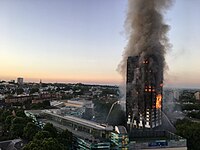
Low evapotranspiration enhances the resilience of peatland carbon stocks to fire
Sign Up to like & getrecommendations! Published in 2017 at "Geophysical Research Letters"
DOI: 10.1002/2017gl074186
Abstract: Boreal peatlands may be vulnerable to projected changes in the wildfire regime under future climates. Extreme drying during the sensitive post-fire period may exceed peatland ecohydrological resilience, triggering long-term degradation of these globally significant carbon… read more here.
Keywords: carbon stocks; post fire; resilience; evapotranspiration ... See more keywords

Greater sage‐grouse respond positively to intensive post‐fire restoration treatments
Sign Up to like & getrecommendations! Published in 2022 at "Ecology and Evolution"
DOI: 10.1002/ece3.8671
Abstract: Abstract Habitat loss is the most prevalent threat to biodiversity in North America. One of the most threatened landscapes in the United States is the sagebrush (Artemisia spp.) ecosystem, much of which has been fragmented… read more here.
Keywords: sagebrush; sage grouse; sage; post fire ... See more keywords

Post‐fire pickings: Large herbivores alter understory vegetation communities in a coastal eucalypt forest
Sign Up to like & getrecommendations! Published in 2022 at "Ecology and Evolution"
DOI: 10.1002/ece3.8828
Abstract: Abstract Fire and herbivores alter vegetation structure and function. Future fire activity is predicted to increase, and quantifying changes in vegetation communities arising from post‐fire herbivory is needed to better manage natural environments. We investigated… read more here.
Keywords: vegetation communities; fire; vegetation; post fire ... See more keywords

Demographic effects of a megafire on a declining prairie grouse in the mixed‐grass prairie
Sign Up to like & getrecommendations! Published in 2022 at "Ecology and Evolution"
DOI: 10.1002/ece3.9544
Abstract: Abstract Recent studies have documented benefits of small, prescribed fire and wildfire for grassland‐dependent wildlife, such as lesser prairie‐chickens (Tympanuchus pallidicintus), but wildlife demographic response to the scale and intensity of megafire (wildfire >40,000 ha) in… read more here.
Keywords: prairie chicken; fire; lesser prairie; post fire ... See more keywords

Climate will increasingly determine post‐fire tree regeneration success in low‐elevation forests, Northern Rockies, USA
Sign Up to like & getrecommendations! Published in 2019 at "Ecosphere"
DOI: 10.1002/ecs2.2568
Abstract: Climate change is expected to cause widespread shifts in the distribution and abundance of plant species through direct impacts on mortality, regeneration, and survival. At landscape scales, climate impacts will be strongly mediated by disturbances,… read more here.
Keywords: post fire; climate; regeneration; seed ... See more keywords

A new approach for modeling delayed fire‐induced tree mortality
Sign Up to like & getrecommendations! Published in 2021 at "Ecosphere"
DOI: 10.1002/ecs2.3458
Abstract: Global change is expanding the ecological niche of mixed-severity fire regimes into ecosystems that have not usually been associated with wildfires, such as temperate forests and rainforests. In contrast to stand-replacing fires, mixed-severity fires may… read more here.
Keywords: new approach; post fire; mixed severity; mortality ... See more keywords

Bumble bee use of post‐fire chaparral in the central Sierra Nevada
Sign Up to like & getrecommendations! Published in 2017 at "Journal of Wildlife Management"
DOI: 10.1002/jwmg.21280
Abstract: Bumble bees (Bombus spp.) are declining across many regions in the Northern Hemisphere, leading to a need for management actions that will protect and enhance their habitats. In the Sierra Nevada of California, USA, montane… read more here.
Keywords: bumble bees; bee; bumble bee; post fire ... See more keywords

Mechanisms behind persistence of a fire-sensitive alternative stable state system in the Gibson Desert, Western Australia
Sign Up to like & getrecommendations! Published in 2019 at "Oecologia"
DOI: 10.1007/s00442-019-04474-1
Abstract: Alternative vegetation types that switch from one to another under contrasting fire regimes are termed fire-mediated alternative stable states (FMASS). Typically, pyrophylic communities (i.e., vegetation assemblages favored by burning) dominate under high frequencies or intensities… read more here.
Keywords: state; post fire; alternative stable; vegetation ... See more keywords

Soil chemistry drives below ground traits in an alternate successional pathway from forest to heath.
Sign Up to like & getrecommendations! Published in 2021 at "Oecologia"
DOI: 10.1007/s00442-021-04864-4
Abstract: To understand impacts of post-disturbance assembly mechanisms on the functional diversity (FD) of plant communities, it is necessary to determine how the environment drives their functional trait composition. In the boreal forest, post-fire abiotic filters… read more here.
Keywords: heath; chemistry; post fire; ground traits ... See more keywords

Post-fire debris flows delay recovery and create novel headwater stream macroinvertebrate communities
Sign Up to like & getrecommendations! Published in 2018 at "Hydrobiologia"
DOI: 10.1007/s10750-018-3534-y
Abstract: Wildfire is one of the most important global agents of disturbance affecting terrestrial and riparian vegetation. Post-fire vegetation changes can alter stream resource pathways and cause channel reorganization and sediment-laden debris flows. Yet, little is… read more here.
Keywords: stream; post fire; debris flows; macroinvertebrate communities ... See more keywords

Influence of fire refugia spatial pattern on post-fire forest recovery in Oregon’s Blue Mountains
Sign Up to like & getrecommendations! Published in 2019 at "Landscape Ecology"
DOI: 10.1007/s10980-019-00802-1
Abstract: ContextFire regimes in many dry forests of western North America are substantially different from historical conditions, and there is concern about the ability of these forests to recover following severe wildfire. Fire refugia, unburned or… read more here.
Keywords: fire; post fire; fire refugia; seed ... See more keywords